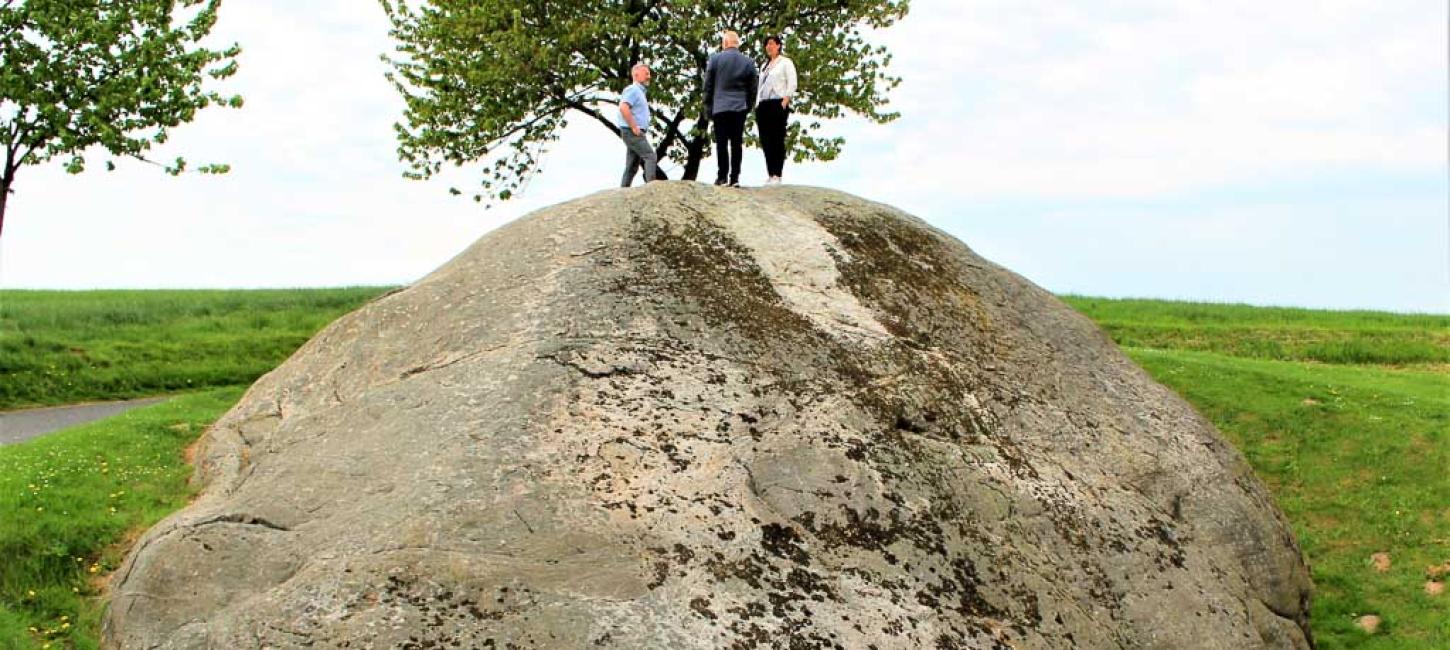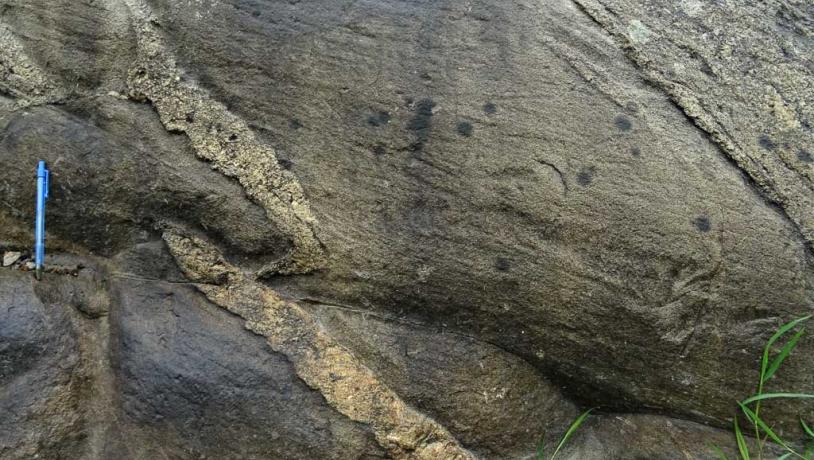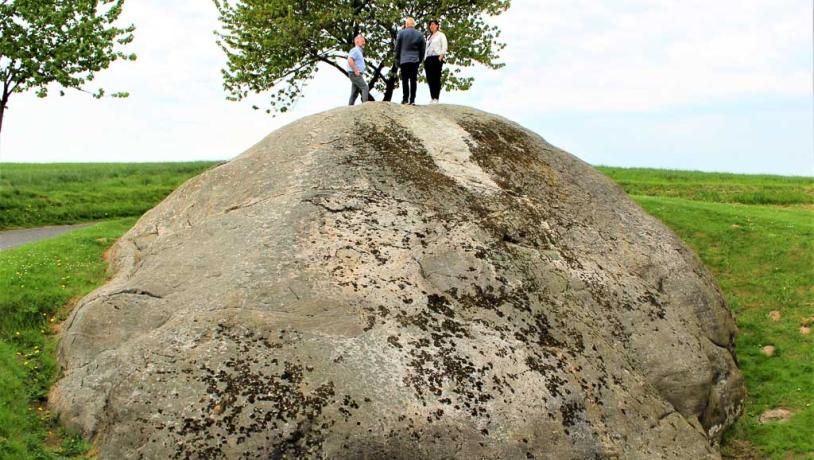
Damestenen (The Lady Stone)
Damestenen, also known as Dammestenen or Hesselagerstenen, is Denmark's largest known glacial erratic boulder on land. It is surrounded by open fields about one kilometre northeast of Hesselager on East Funen.
The giant boulder has been a tourist attraction ever since it was first described in 1763. Signs point the way to the site, where there is a car park that can also accommodate tourist coaches.
In 1840, Damestenen was investigated by geologist J.G. Forchhammer, who believed that it may have continued deeper into the ground than its visible top suggested. On 8 April 1846, the boulder was protected and donated to the state by landowner Dons of Hesselagergård. On the orders of King Christian VIII, the north-eastern side of Damestenen was excavated - probably to investigate whether the colossus was solid bedrock protruding from the Funen soil or whether it was just a loose but unusually large boulder. Today we know that the bedrock beneath Funen is more than 800 metres down.
The boulder has never been fully excavated, so we do not know its exact size. However, it is approximately 13 metres long, 10 metres wide, 6.5 metres high (visible height), 46.8 metres in circumference and has an estimated weight of just over 1200 tonnes.
On the surface of the boulder there are 12 Bronze Age cup marks, but they are difficult to see.

Photo:Søren Skibsted
Geology of Damestenen
The first lady among Denmark's giant boulders has yet to be studied with modern methods and knowledge that would give us a far more nuanced picture of the boulder's geological history than we have today.
However, this history may very well have begun when a granite crystallised from a molten rock mass (magma) in a large magma chamber deep in the Earth's crust. The granite became part of the Swedish bedrock.
Damestenen is often referred to as a light reddish grey, medium-grained granite. However, large parts of the boulder seem to consist of striped areas with folds, which suggests that at some point the stone material was exposed to such high pressure and temperature that it became malleable and the minerals could organise themselves into light and dark bands. This type of rock is called gneiss.
At some point, cracks appeared in the granite/gneiss and a dark, volcanic lava flowed into the cracks. When the lava solidified, it became the dark grey, fine-grained veins and inclusions of the diabase rock type seen in the stone. Damestenen also contains light-coloured, coarse-grained veins, known as pegmatites.
Millions of years of erosion of the bedrock and crustal movements gradually brought the granite/gneiss to the surface. Here, Damestenen was wrenched from the bedrock by the glaciers of the Ice Age and transported from Sweden to Denmark. During transport, the boulder was rounded, polished and scoured before being pressed down into the moraine clay under the glacier at Hesselager and frozen solid.
As the glacier continued over the boulder, the frozen stones scoured the bottom of the ice against the surface of Damestenen. In this way, the south-east side of Damestenen - which faced the direction of ice movement (the push side) - was sanded smooth and scored with scratch marks (scour marks), reflecting the direction of ice movement from south-east to north-west. On the north-west side (leeward side), the ice 'plucked' pieces of the stone, so that today this side appears steep and rough.
Damestenen was probably deposited by one of the Young Baltic ice streams during the last ice age, the Weichselian, within the period 17-19,000 years before present. However, on its journey from Sweden to Denmark, the stone may well have been 'tossed between several different ice streams before finding its final resting place at Hesselager.
Legends and myths
As an alternative to geological considerations, folklore abounds with alternative explanations. A common thread in the legends is that either a sorceress, giantess, witch, troll or giant on Langeland felt violently disturbed by the church bells in Svindinge church, and therefore threw a giant boulder in the direction of the church tower. However, the forces failed and the boulder landed in a field near Hesselager. The person in question was also unhappy that sailors were using the church spire as a sea mark and thus avoiding shipwrecks.
Some, however, have doubted the boulder thrower's enormous powers and believe that Damestenen only grew to its present size after the flight, as stones are known to grow by the smell of freshly baked bread.
The throwing legend has an extra twist in some tales, where an angel set foot on the flying giant boulder and prevented it from hitting its target. You can see the imprint of the angel's foot on the top of Damestenen.

Photo:Søren Lisby
The landscape of the future
From a geological perspective, the glacial landscape around Damenstenen is unlikely to change significantly in the foreseeable future. In terms of landscape, the boulder is located on the surface of a gently undulating moraine surface characterised by yellow-brown moraine clay, where both elements can probably be linked to the part of the Bælthav Ice Stream (17-18,000 years before present) known as the "Great Belt Glacier". Just north of Damestenen, the moraine surface slopes down towards the strikingly incised river valley, through which the Stokkebækken stream flows.
Future increases in precipitation could affect the groundwater level and runoff conditions in the area and thereby - possibly periodically - increase the flow in watercourses such as Stokkebækken. There is often water at the bottom of the deep excavation around Damestenen, and after periods of heavy rainfall, the water depth can easily exceed one metre.
The site itself covers only a very small area and is surrounded by cultivated fields without significant nature interests.
Value
As Denmark's largest known glacial erratic boulder on land, Damestenen naturally has a very high geological and cultural-historical value and is visited by thousands of tourists every year. Large boulders in general have always attracted attention and are usually surrounded by an aura of superstition, legends and myths. The boulder is also of archaeological significance with its 12 Bronze Age bowl signs.
With its impressive size, Damestenen is also a fine example of a glacier's power and ability to transport even large and heavy objects, as well as to grind, polish and scratch hard materials.
In principle, Damestenen is of great research value and, simply by being known as 'Denmark's largest stone', deserves a systematic geological (petrographic) study using modern technology, description in modern terms and incorporation of our contemporary knowledge of the rock-forming processes. However, the conservation and protection of the boulder as a cultural and historical monument means that on previous occasions applications for investigations involving interference with the surface of the boulder have been refused.
Damestenen was listed in 1846 and the surrounding land parcel in 1941. The boulder is classified as an Area of National Geological Interest NGI 203.
Longitude: 10.760583
Latitude: 55.181735